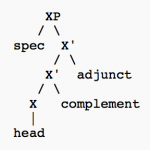SMPC Day 3: Session 2 (Structure and Syntax)
 The mid morning of Saturday featured a neat little session called ‘Structure and Syntax’ but which might more accurately have been labelled ‘Rhythm’, since all 3 speakers were interested in the structure and syntax of the beat to our music (and, as we shall see, our speech).
The mid morning of Saturday featured a neat little session called ‘Structure and Syntax’ but which might more accurately have been labelled ‘Rhythm’, since all 3 speakers were interested in the structure and syntax of the beat to our music (and, as we shall see, our speech).
The first speaker was Ani Patel (Tufts University, USA).
Ani introduced us to a new approach for the historical study of musical rhythm. I found it to be a very intriguing idea, as very little in the way of traditional scientific analysis is done on historical data. But in music we are of course blessed with many great volumes of musical score going back hundreds of years. So why not use them to see how our rhythms have changed over time?
Ani’s empirical measure is the nPVI (normalized pairwise familiarity index), an equation that measures the degree of duration contrast between successive events in a musical sequence. The nPVI can also be applied to look at duration contrasts in speech utterances and traditionally the measure has been used in comparison studies of music and language structure.
In the present study Ani and his collaborator used the nPVI to look at German/Austrian music and Italian Classical music between about 1600 and 1900, with the help of the wonderful compondeum “The Dictionary of Musical Themes”.
 Ani reported an interesting difference. He looked at German/Austrain and Italian composers who had produced at least 15 themes in the Dictionary and who had not migrated for a signficant period of time to countries that spoke a different language. Italian composers used a more or less fixed nPVI of around 40 for the whole of the period. German composers on the other hand went from an nPVI of lower than 30 to one of over 70 (I think – from my memory of the figure!)
Ani reported an interesting difference. He looked at German/Austrain and Italian composers who had produced at least 15 themes in the Dictionary and who had not migrated for a signficant period of time to countries that spoke a different language. Italian composers used a more or less fixed nPVI of around 40 for the whole of the period. German composers on the other hand went from an nPVI of lower than 30 to one of over 70 (I think – from my memory of the figure!)
Why? Why had German music changed? Interestingly this finding corresponds to a report in the musicology literature that German music changed rapidly around the late 1700s with a rise in German nationalism and an abandonment of the fashion towards Italian styling. Therefore the nPVI looks like an interesting research tool for investigating patterns in musical composing habits, both in global and historical terms and, as Ani noted, across the lifetime of single composers.
The next speaker was Rie Asano (University of Cologne, Germany) who presented a theoretical paper on the principles of rhythmic syntax. The idea of rhythm syntax is not a new one but it has always played a much lower role than the more popular study of musical pitch and harmonic syntax. Rie hoped to inspire us with a few thoughts on the nature of rhythm also having principles that govern the combination of discrete elemnts into hierarchy.
 She argued that rhythmic syntax accounts for the temporal organisation of music in which elements, or beats, are combined to generate well formed metrical and grouping structures. She presented ideas relating to Headedness and Discrete Infinity as well as phrase structure, all of which are essential components of linguistic syntax but can also be considered in terms of rhythmic syntax.
She argued that rhythmic syntax accounts for the temporal organisation of music in which elements, or beats, are combined to generate well formed metrical and grouping structures. She presented ideas relating to Headedness and Discrete Infinity as well as phrase structure, all of which are essential components of linguistic syntax but can also be considered in terms of rhythmic syntax.
Rie had some interesting thoughts on the uniqueness of rhythmic syntax to humans and is planning experiments with collaborators to look at spontaneous rhythmic structures in our ape cousins. This is based on the idea that action syntax represents a strong connection between rhythmic cognition and the capacity for synchronisation, and emphasises the important role of sensory motor interface in the possible evolution of rhythmic syntax.
The final speaker was Maeve McMahon (University of Westminster, UK) who presented a nice study looking at the effect of musical training and native language on beat perception. Maeve used a paradigm developed by Devin McAuley called the Ambiguous Tempo Paradigm (ATP). I wrote about the ATP when I first saw it presented at ICMPC and you can read the details here
Essentially the paradigm involves litening to a series of beats and saying whether you think they are slowing down or speeding up. Your response under different conditions tells whether your timing judgement is beat based or interval based.
 Maeve was interested in; 1) whether musicians would show improved timing judegments and, 2) whether the difference between speaking a stress timed (English) or syllable timed (French) language would influence how people based their timing judgements.
Maeve was interested in; 1) whether musicians would show improved timing judegments and, 2) whether the difference between speaking a stress timed (English) or syllable timed (French) language would influence how people based their timing judgements.
Her results showed that musicians were overall better than nonmusicians at getting the right answer on this test, meaning they were better at discriminating time intervals in the subsecond range.
 The crucial interaction of interest was that the English native speakers were more likely to use a beat based timing response than the French speakers. So here we have another piece of evidence that there is an association between language and music in terms of how the timing of one impacts on the perception of timing in another – though the issue of whom influences whom is anyones guess!
The crucial interaction of interest was that the English native speakers were more likely to use a beat based timing response than the French speakers. So here we have another piece of evidence that there is an association between language and music in terms of how the timing of one impacts on the perception of timing in another – though the issue of whom influences whom is anyones guess!
I always enjoy thinking about rhythm and music psychology, since it is not something I work on as part of my research. This session gave plenty of food for thought. In particular I enjoyed seeing the interaction between historical musicology, as well as current language use, and our understanding of the impact of rhythm on cognition. The beat goes on!
One Comment
Pingback: